Berberis
Berberis (/ˈbɜːrbərɪs/), commonly known as barberry,[1][2] is a large genus of deciduous and evergreen shrubs from 1–5 m (3.3–16.4 ft) tall, found throughout temperate and subtropical regions of the world (apart from Australia). Species diversity is greatest in South America and Asia; Europe, Africa and North America have native species as well. The best-known Berberis species is the European barberry, Berberis vulgaris, which is common in Europe, North Africa, the Middle East, and central Asia, and has been widely introduced in North America. Many of the species have spines on the shoots and all along the margins of the leaves.[3][4]
| Berberis | |
|---|---|
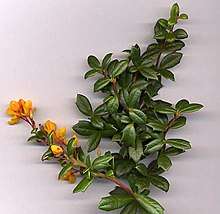 | |
| Berberis darwinii shoot with flowers | |
 | |
| Berberis thunbergii shoot with fruit | |
| Scientific classification | |
| Kingdom: | Plantae |
| Clade: | Tracheophytes |
| Clade: | Angiosperms |
| Clade: | Eudicots |
| Order: | Ranunculales |
| Family: | Berberidaceae |
| Genus: | Berberis L. |
| Type species | |
| Berberis vulgaris | |
| Species | |
Description
The genus Berberis has dimorphic shoots: long shoots which form the structure of the plant, and short shoots only 1–2 mm (0.039–0.079 in) long. The leaves on long shoots are non-photosynthetic, developed into one to three or more spines[5]:96 3–30 mm (0.12–1.18 in) long. The bud in the axil of each thorn-leaf then develops a short shoot with several normal, photosynthetic leaves. These leaves are 1–10 cm (0.39–3.94 in) long, simple, and either entire, or with spiny margins. Only on young seedlings do leaves develop on the long shoots, with the adult foliage style developing after the young plant is 1–2 years old.
Many deciduous species, such as Berberis thunbergii and B. vulgaris, are noted for their attractive pink or red autumn color. In some evergreen species from China, such as B. candidula and B. verruculosa, the leaves are brilliant white beneath, a feature valued horticulturally. Some horticultural variants of B. thunbergii have dark red to violet foliage.
The flowers are produced singly or in racemes of up to 20 on a single flower-head. They are yellow or orange, 3–6 mm (0.12–0.24 in) long, with six sepals and six petals in alternating whorls of three, the sepals usually colored like the petals. The fruit is a small berry 5–15 mm (0.20–0.59 in) long, ripening red or dark blue, often with a pink or violet waxy surface bloom; in some species, they may be long and narrow, but are spherical in other species.
Some authors regard the compound-leaved species as belonging to a different genus, Mahonia. There are no consistent differences between the two groups other than the leaf pinnation (Berberis sensu stricto appear to have simple leaves, but these are in reality compound with a single leaflet; they are termed "unifoliolate"[6]), and many botanists prefer to classify all these plants in the single genus Berberis.[3][7][8][9] However, a recent DNA-based phylogenetic study retains the two separate genera, by clarifying that unifoliolate-leaved Berberis s.s. is derived from within a paraphyletic group of shrubs bearing imparipinnate evergreen leaves, which the paper then divides into three genera: Mahonia, Alloberberis (formerly Mahonia section Horridae), and Moranothamnus (formerly Berberis claireae); it confirms that a broadly-circumscribed Berberis (that is, including Mahonia, Alloberberis, and Moranothamnus) is monophyletic.[10]
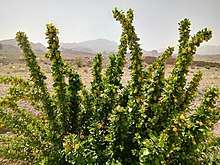
Ecology
Berberis species are used as food plants by the larvae of some Lepidoptera species, including the moths barberry carpet moth (Pareulype berberata), and mottled pug (Eupithecia exiguata).
Berberis species can infect wheat with stem rust, a serious fungal disease of wheat and related grains.[11] Berberis vulgaris (European barberry) and Berberis canadensis (American barberry) serve as alternate host species of the rust fungus responsible, the wheat rust fungus (Puccinia graminis). For this reason, cultivation of B. vulgaris is prohibited in many areas, and imports to the United States are forbidden. The North American B. canadensis, native to Appalachia and the Midwest United States, was nearly eradicated for this reason, and is now rarely seen extant, with the most remaining occurrences in the Virginia mountains.
Some Berberis species have become invasive when planted outside of their native ranges, including B. glaucocarpa and B. darwinii in New Zealand (where it is now banned from sale and propagation), and B. vulgaris and green-leaved B. thunbergii in much of the eastern United States.
Cultivation
Several species of Berberis are popular garden shrubs, grown for such features as ornamental leaves, yellow flowers, or red or blue-black berries. Numerous cultivars and hybrids have been selected for garden use. Low-growing Berberis plants are also commonly planted as pedestrian barriers. Taller-growing species are valued for crime prevention; being dense and viciously spiny, they are effective barriers to burglars. Thus they are often planted below vulnerable windows, and used as hedges. Many species are resistant to predation by deer.
Species in cultivation include:
The following hybrid selections have gained the Royal Horticultural Society's Award of Garden Merit:
Culinary uses
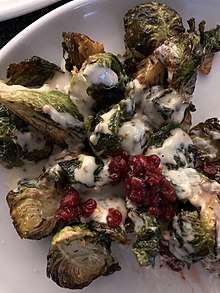
Berberis vulgaris grows in the wild in much of Europe and West Asia. It produces large crops of edible berries, rich in vitamin C, but with a sharp acid flavour. In Europe for many centuries the berries were used for culinary purposes much as citrus peel is used. Today in Europe they are very infrequently used. The country in which they are used the most is Iran, where they are referred to as zereshk (زرشک) in Persian. The berries are common in Persian cuisine such as in rice pilaf (zereshk polo) and as a flavouring for poultry. Because of their sour flavor, they are sometimes cooked with sugar before being added to Persian rice. Iranian markets sell dried zereshk. In Russia it sometimes used in jams (especially with mixed berries), and extract of barberries is a common flavoring for soft drinks, candies, and sweets.
Berberis microphylla and B. darwinii (both known as calafate and michay) are two species found in Patagonia in Argentina and Chile. Their edible purple fruits are used for jams and infusions.
Traditional medicine
The dried fruit of Berberis vulgaris is used in herbal medicine.[17] The chemical constituents include isoquinolone alkaloids, especially berberine. A full list of phytochemicals was compiled and published in 2014.[18] The safety of using berberine for any condition is not adequately defined by high-quality clinical research.[19] Its potential for causing adverse effects is high, including untoward interactions with prescription drugs, reducing the intended effect of established therapies.[19] It is particularly unsafe for use in children.[19] There is considerable evidence that berberine is toxic.[20]
Other uses
Historically, yellow dye was extracted from the stem, root, and bark.[21]
The thorns of the barberry shrub have been used to clean ancient gold coins, as they are soft enough that they won't damage the surface but will remove corrosion and debris.[22]
Gallery
- Berberis aggregata, fruits.
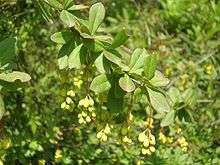 Berberis aristata, from the Himalayas
Berberis aristata, from the Himalayas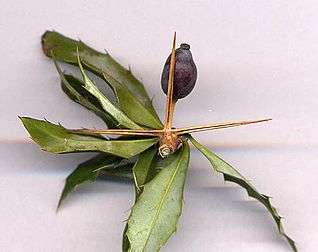 Berberis hybrid, with three-spined thorn (modified long shoot leaf) with leafy short shoot. Each thorn is 20 mm (0.79 in) long.
Berberis hybrid, with three-spined thorn (modified long shoot leaf) with leafy short shoot. Each thorn is 20 mm (0.79 in) long.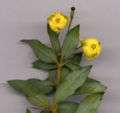 Berberis hybrid, flower detail (flowers 7 mm (0.28 in) diameter).
Berberis hybrid, flower detail (flowers 7 mm (0.28 in) diameter). Berberis hybrid, fruit.
Berberis hybrid, fruit.- Berberis thunbergii, shrub.
 Berberis valdiviana, flowers, from Chile (cultivated at Birmingham Botanical Gardens)
Berberis valdiviana, flowers, from Chile (cultivated at Birmingham Botanical Gardens)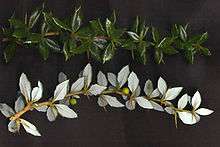 Berberis verruculosa, upper side of shoot above, lower side below.
Berberis verruculosa, upper side of shoot above, lower side below.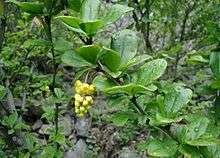 Berberis vulgaris, flowers and foliage, cultivated in Denmark
Berberis vulgaris, flowers and foliage, cultivated in Denmark Berberis prattii, fruit
Berberis prattii, fruit Barberry blossom in Eastern Siberia
Barberry blossom in Eastern Siberia
References
- English Names for Korean Native Plants (PDF). Pocheon: Korea National Arboretum. 2015. p. 371. ISBN 978-89-97450-98-5. Archived from the original (PDF) on 25 May 2017. Retrieved 26 January 2017 – via Korea Forest Service.
- Wedgwood, Hensleigh (1855). "On False Etymologies". Transactions of the Philological Society (6): 66.
- "Berberis fremontii in Flora of North America @ efloras.org". www.efloras.org.
- Flora of China Vol. 19 Page 715 小檗属 xiao bo shu Berberis Linnaeus, Sp. Pl. 1: 330. 1753.
- Stace, C. A. (2010). New Flora of the British Isles (Third ed.). Cambridge, U.K.: Cambridge University Press. ISBN 9780521707725.
- Pabón-Mora, Natalia; González, Favio (2012). "Leaf development, metamorphic heteroblasty and heterophylly in Berberis s. l. (Berberidaceae)". The Botanical Review. 78 (4): 463–489. doi:10.1007/s12229-012-9107-2.
- Loconte, H., & J. R. Estes. 1989. Phylogenetic systematics of Berberidaceae and Ranunculales (Magnoliidae). Systematic Botany 14:565-579.
- Marroquín, Jorge S., & Joseph E. Laferrière. 1997. Transfer of specific and infraspecific taxa from Mahonia to Berberis. Journal of the Arizona-Nevada Academy of Science 30(1):53-55.
- Laferrière, Joseph E. 1997. Transfer of specific and infraspecific taxa from Mahonia to Berberis. Botanicheskii Zhurnal 82(9):96-99.
- Yu, Chih-Chieh; Chung, Kuo-Fang (2017). "Why Mahonia? Molecular recircumscription of Berberis s.l., with the description of two new genera, Alloberberis and Moranothamnus". Taxon. 66 (6): 1371–1392. doi:10.12705/666.6.
- "Biologists Spot First UK Case Of An Ancient Crop Disease In Six Decades".
- "RHS Plant Selector Berberis 'Georgei' AGM / RHS Gardening". Apps.rhs.org.uk. Retrieved 2020-04-17.
- "RHS Plant Selector Berberis × lologensis 'Apricot Queen' AGM / RHS Gardening". Apps.rhs.org.uk. Retrieved 2020-04-17.
- "RHS Plant Selector Berberis × media 'Red Jewel' AGM / RHS Gardening". Apps.rhs.org.uk. Retrieved 2013-04-07.
- "RHS Plant Selector Berberis × stenophylla 'Corallina Compacta' AGM / RHS Gardening". Apps.rhs.org.uk. Retrieved 2020-04-17.
- "RHS Plant Selector Berberis × stenophylla Lindl. AGM / RHS Gardening". Apps.rhs.org.uk. Retrieved 2020-04-17.
- See e.g. "Barberry" @ Alternative Medicine @ University of Maryland Medical Center
- Mokhber-Dezfuli N, Saeidnia S, Gohari AR, Kurepaz-Mahmoodabadi M. Phytochemistry and pharmacology of berberis species. Pharmacogn Rev. 2014;8(15):8–15. doi:10.4103/0973-7847.125517
- "Berberine: MedlinePlus Supplements". MedlinePlus, National Library of Medicine, US National Institutes of Health. 19 January 2019. Retrieved 15 February 2019.
- "Berberine". PubChem, National Library of Medicine, US National Institutes of Health. March 9, 2020. Retrieved March 10, 2020.
- C. Tomlinson (1866). Berberis. Tomlinson's Cyclopaedia of Useful Arts. I. London: Virtue & Co. p. 97.
- "From the Trenches". Archaeology: 9. July–August 2017.
- Murrills, Angela (2005-11-24). "Best Eating: Check, please". Straight.com. Retrieved 2007-05-02.
- Wilkinson, Bobbie; Tom Wilkinson (2004-08-15). "It's an Adventure in Persian Cuisine at Darya Kabob". The Washington Post. Retrieved 2007-05-02.
- Arellano, Gustavo (2004-03-18). "Naan & Kabob". Orange County Weekly. Archived from the original on 2007-10-10. Retrieved 2007-05-02.
- Royal New Zealand Institute of horticulture. Berberis glaucocarpa
External links
| Wikimedia Commons has media related to Berberis. |
| Wikispecies has information related to Berberis |
| Wikisource has the text of the 1911 Encyclopædia Britannica article Barberry. |
- Platt, Karen, "Gold Fever" descriptions of golden or yellow leaved Berberis http://www.karenplatt.co.uk